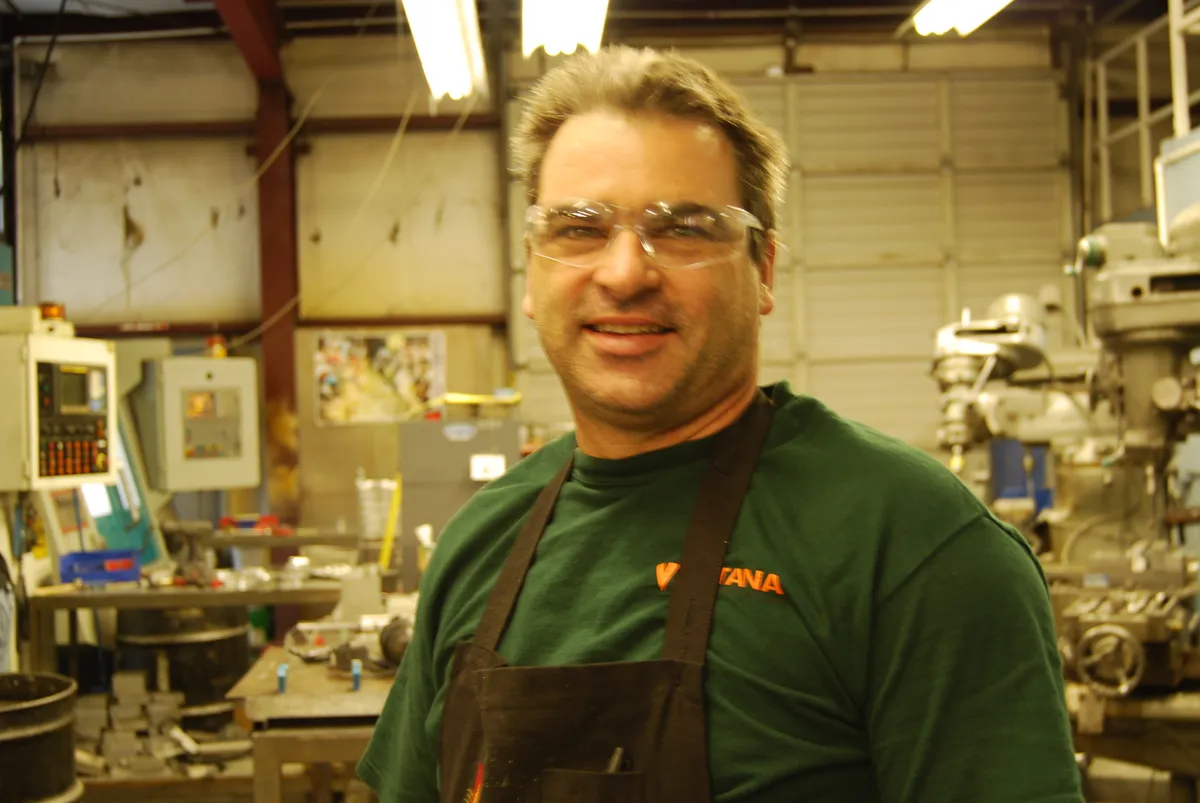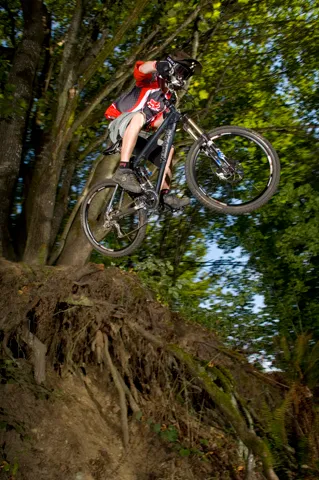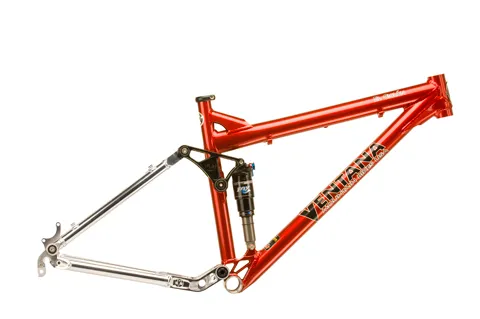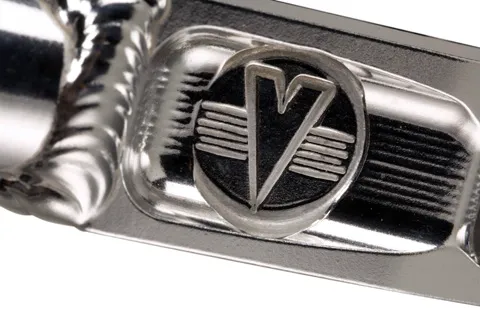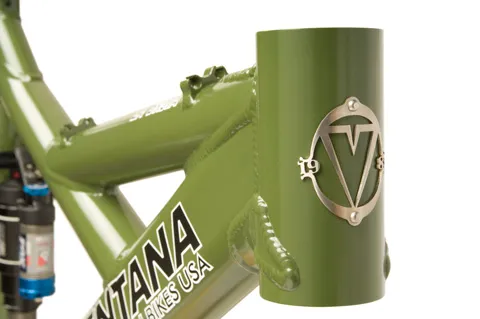Sherwood Gibson is the co-founder of Ventana Mountain Bikes USA. You may not have heard of him before, and that’s because he isn’t interested in self-publicity or marketing. Fortunately for him, he doesn’t need to be: people either buy his frames because they’ve had one in the past and want another, or because they’ve heard the way pro bike testers tirelessly rave about them.
We discuss how Sherwood runs a company, what gets him up for work in the morning and how Ventana has become a family for this enigmatic mechanical engineer.
Where it all began
Sherwood started out on BMX bikes in 1974, racing them locally at the weekend. “Before long I was refining and welding my own bikes in my parents’ garage with encouragement from both my father and High School metal shop teacher. This led to a ten-year stint in college with a heavy concentration on the craft of metal working and, ultimately, a degree in mechanical engineering.”
Sherwood got frustrated at trying to fit his 5 foot 7 inch body onto the standard 18 and 19 inch bicycle frames of the early 1980s. Instead of putting up with it, he started making custom steel mountain bike frames.
"Racing on weekends and making geometry tweaks and frame modifications during the week allowed me to get first-hand feedback of the integrity and functionality of my designs,” he says. “By 1988, Ventana Mountain Bikes USA was born.”
What’s in a name?
The Ventana name is attributed to Sherwood’s co-founder, Steve Blalock. As Sherwood says, “Steve really had a connection to the picturesque vistas and rugged mountain trails in the Ventana Wilderness area [in Big Sur, California] and wanted to capture that feeling in our company's namesake.” That name, like so many areas of California, is of Spanish linguistic origin.
In 1991, when Sherwood bought Steve out of the company, he was keen to continue Ventana’s naming legacy. As each new frame is produced he suggests an English name to Teresa Franco, his Business Manager, who comes up with the Spanish equivalent. If the translation clicks, the name goes into production - as frames such as El Saltamontes and El Ciclón (‘the mountain jumper,’ and ‘the cyclone’) demonstrate.
There’s only one frame in the current lineup without a Spanish name, the X-5. Was it a blip, an oversight or a deliberate experiment? Sherwood explained that it was an un-named 5 inch travel frame (the number ‘5’) that had an x-braced top tube design (the ‘X’).
“I kept pestering Teresa for a suitable name in the weeks leading up to the Interbike tradeshow, but we just couldn’t find a name that clicked, so the X-5 name was born and it stuck.”
Small company, big ideals
With such a well established range and the support of critics it can be surprising that Ventana is still a relative unknown, but Sherwood is a firm believer that subjecting his company to high profile marketing and market forces would be a risky step to take.
"I am not interested in gaining new customers at the cost of alienating our existing customers"
"Fortunately for me, I have extremely high job satisfaction and I like coming to work everyday to build cool stuff. The carrot is the work and the bonus is the customer's accolades once they have become Ventana family members. Our new customers come via word-of-mouth through our hard work, our distributor's dogged efforts and our customer's feedback. It works for us and our customers are happy, so I can look in the mirror everyday and feel good about my integrity. I don't have to try to peel open someone's wallet to get a sale based on a ‘new and improved improvement over last year's improvement.’"
Twenty years into the business that firmness of belief also extends to customer care. “I am not interested in gaining new customers at the cost of alienating our existing customers just for the sake of having something new,” says Sherwood. “Instead, we innovate every day to make our products better. We incorporate changes that are necessary in real time. This is what our customers appreciate and what they ultimately demand."
Within this, he watches the industry closely for innovation, but only when it goes beyond a fad is he willing to think about incorporating it to improve his own designs. The focus is on the financial constraints of being a small company, but also on wanting to give the customer the best available and proven products.
I was keen to know what he felt was the main technology innovation that drives his designs forward. “That’s simple,” says Sherwood, “fork travel. The evolution in fork design defines what we then go and try to do.”
Step back when needed
But even though the company is keen to move forward once innovations become accepted, they aren’t afraid to maintain an existing range if it’s what their customers want.
The El Ciclón was released in 2007 to replace the X-5 as the company’s all-mountain bike and, although it was a success, customer feedback suggested that some people still wanted the X-5. “[It] was used as a weapon of choice by a number of dual slalom/four cross privateers who loved its tight geometry, stiff chassis and low stand-over height.” Sherwood says.
As a result, he’s happy to keep the X-5 going alongside the newer El Ciclón, reiterating his belief that, “the philosophy of a bicycle company should be about meeting the demands of your existing customers as much as pushing innovation.”
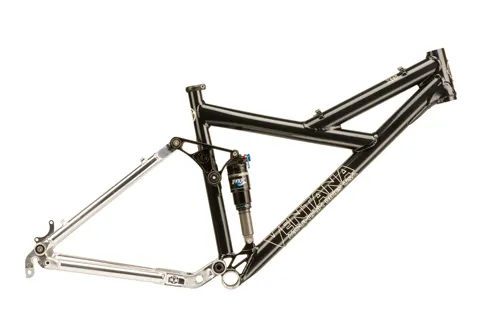
The X5 is still favoured for it's low stand-over height and strong x-bar frame
Bespoke
If the existing in-house builds are not to someone’s exact requirements, Sherwood will happily work with the customer to help them get just what they want for a small additional fee (ranging from $200 for adjustments to seat tube up to $700 extra for full custom builds). Sherwood is keen to speak to customers on the phone, “to get a picture of their riding styles and preferred terrains. Diagrams are faxed back and forth until an exact frame is decided upon to be built precisely."
This approach also extends to the standard frames. They come in a range of options, to suit the rider’s needs. For example, the El Ciclón frame is interchangeable between the 5 and 6 inch versions by fitting a different shock and rocker as required.
Stiffness and effciency
With the amount of repeat business he gets Sherwood’s company philosophy is clearly working, but what makes his bikes different from the multitude of full suspension bikes that claim to have the most efficient suspension system out there? Sherwood argues that although these claims sometimes hold up in two dimensional drawings, it’s a different matter out on the trail.
“What I’m trying to achieve is a simple, elegant solution to a complex design problem. If anything, this is the epitome of my design philosophy. Why make it overly complex and increase maintenance when you can make it as good or better with cleaner lines and fewer parts? It doesn't make sense to us to have a super efficient pedaling platform if you forsake lateral stiffness and can't make the turn at the end of a straight section because the rear end of your bike is too flexy.”
What Mountain Bike’s Guy Kesteven reported when testing the El Ciclón that this stiffness, combined with the bike’s willing suspension, equals major results on the trail. It’s a bike that Guy feels enables the rider to take lines through technical terrain and corners that “you’ve always stumbled over before, with your mates a distant memory in the dust cloud.”
“A frame that is stiffer laterally will always out-corner a more compliant foe,” Sherwood explains, “because it’s less influenced by the sideways forces applied when your rear wheel encounters a rut or rock.”
He also feels that his designs enable you: “to jump and slide more predictably because your rear wheel will more closely stay in the plane of your front triangle instead of flexing outward and giving the tire enough outward bite to throw you out of your groove. “
Similarly, his bikes are renowned for their ability to climb technical terrain as much as descend it. “This comes from my design’s ability to allow the rider to feel and use the trail, not be separated from it due to theoretical ‘efficiency’ coupled with real-world flexiness.”
Handmade is a way of life
Along with his strongly held views on design, Sherwood is proud of being an active member of the North American Handmade Bicycle industry. All Ventana frames are built in-house in their Rancho Cordova facility in Northern California and outsourced materials are brought in from local companies and dealers where possible. The amazing thing is that they are as competitive in the American market as many of their peers who outsource their frames to be made in the Far East. How is this possible?
“Right now, the US dollar is weak across the globe. This minimizes most of the advantages of importing from Asia for US companies, as their buying power is much lower than in years past (when the dollar was comparatively strong). Since we do nearly everything in-house, and source US materials whenever possible, we’re less influenced by fluctuations in the dollar value globally. As a result, our costs of doing business stay fairly stable which allows us to build better products for the same dollar.”
In Europe, the frames are even more competitively priced. “This is again influenced by the weak dollar and further enhanced by our relationship with our importers, such as Alan at Riverside Cycles (the UK importer),” Sherwood says. “Ventana has been in business for twenty years, but to many customers outside of the US we’re an unknown brand. To offset this, we have kept our import prices low to help expand the Ventana name globally. Alan does a fantastic job of spreading the word and is a perfect extension to the Ventana family.”
There’s a danger in reading this article you’ll feel that Sherwood is only interested in his existing customers, but that would be far from the truth. He’s overwhelmed by the positive reviews his products receive and is excited about the new customers coming in. Sherwood and Teresa have worked hard to maintain one of the best customer service and trade-in departments (yep, you can trade in your old frame towards an updated one) in the industry, as well as learning from customer feedback to keep meeting expectation and demand.
